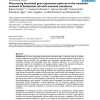35 search results - page 4 / 7 » On Appropriate Adaptation Levels for the Learning of Gene Li... |
BMCBI
2010
13 years 7 months ago
2010
nd: Gene regulatory network is an abstract mapping of gene regulations in living cells that can help to predict the system behavior of living organisms. Such prediction capability...
BMCBI
2008
13 years 7 months ago
2008
Background: In the adaptive immune system, variable regions of immunoglobulin (IG) are encoded by random recombination of variable (V), diversity (D), and joining (J) gene segment...
BMCBI
2006
13 years 7 months ago
2006
Background: Microarray technology produces gene expression data on a genomic scale for an endless variety of organisms and conditions. However, this vast amount of information nee...
COST
2009
Springer
13 years 4 months ago
2009
Springer
Synchrony is claimed by psychology as a crucial parameter of any social interaction: to give to human a feeling of natural interaction, a feeling of agency [17], an agent must be a...
RAS
2010
13 years 5 months ago
2010
Grasping an object is a task that inherently needs to be treated in a hybrid fashion. The system must decide both where and how to grasp the object. While selecting where to grasp...

